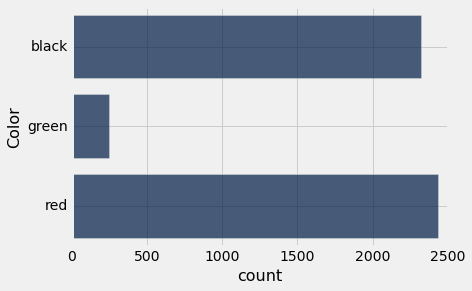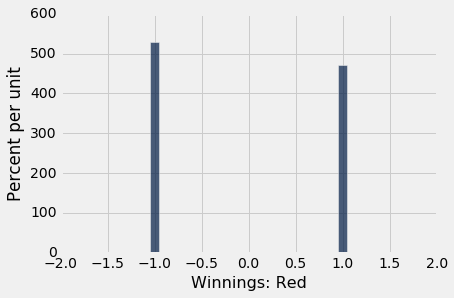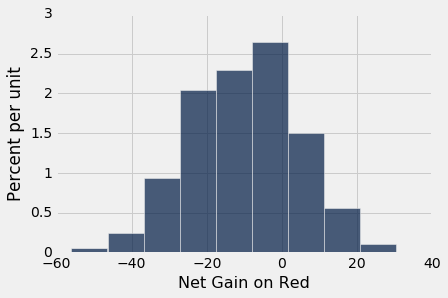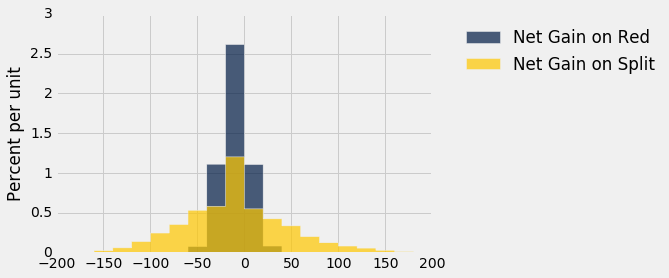At the Roulette Table¶
The distributions above gave us a picture of the entire random sample. But sometimes we are just interested in one or two quantities computed based on the sample.
For example, suppose the sample consists of wins and losses in a series of bets. Then we might just be interested in the total amount of money won, rather than the entire sequence of wins and losses.
Equipped with our new knowledge about the long-run behavior of chances, let us explore a gambling game. We will simulate betting on roulette, which is popular in gambling centers such as Las Vegas and Monte Carlo.
The main randomizer in roulette in Nevada is a wheel that has 38 pockets on its rim. Two of the pockets are green, eighteen black, and eighteen red. The wheel is on a spindle, and there is a small ball on the wheel. When the wheel is spun, the ball ricochets around and finally comes to rest in one of the pockets. That is declared to be the winning pocket.
The table wheel represents the pockets of a Nevada roulette wheel.
wheel
You are allowed to bet on several pre-specified collections of pockets displayed on a roulette table. If you bet on "red," you win if the ball comes to rest in one of the red pockets.
The bet on red pays even money. That is, it pays 1 to 1. To understand what this means, assume you are going to bet \$1 on "red." The first thing that happens, even before the wheel is spun, is that you have to hand over your \$1. If the ball lands in a green or black pocket, you never see that dollar again. If the ball lands in a red pocket, you get your dollar back (to bring you back to even), plus another \$1 in winnings.
The function red_winnings takes a color as its argument and returns 1 if the color is red. For all other colors it returns -1. We apply red_winnings to the Color column of wheel to get a new table bets that shows the net gain on each pocket if you bet \$1 on red.
def red_winnings(color):
if color == 'red':
return 1
else:
return -1
bets = wheel.with_column(
'Winnings: Red', wheel.apply(red_winnings, 'Color')
)
bets
Suppose you decide to bet \$1 on red. What might happen?
Here is a simulation of 1 spin.
one_spin = bets.sample(1)
one_spin
The color of the spin is the value in the Color column. Regardless of your bet, the outcome might be red, green, or black. To see how often those events happen, we can simulate many of these single spins and draw a bar chart of the colors we see. (We could call this an empirical bar chart.)
To do that, we can use a for loop. We have chosen 5,000 repetitions here, but you can change that when you run the cell.
num_simulations = 5000
colors = make_array()
winnings_on_red = make_array()
for i in np.arange(num_simulations):
spin = bets.sample(1)
new_color = spin.column("Color").item(0)
colors = np.append(colors, new_color)
new_winnings = spin.column('Winnings: Red')
winnings_on_red = np.append(winnings_on_red, new_winnings)
Table().with_column('Color', colors)\
.group('Color')\
.barh('Color')
18 out of 38 pockets are red, and each is equally likely. So out of 5,000 simulations, we'd expect to see roughly (but probably not exactly) $\frac{18}{38} \times 5000$, or 2,368, red spins. The simulation bears that out.
In the simulation, we also recorded your winnings. An empirical histogram of those shows the (approximate) chances of different outcomes of your \$1 bet on red.
Table().with_column('Winnings: Red', winnings_on_red)\
.hist(bins = np.arange(-1.55, 1.65, .1))
The only possible outcome of each simulation is that you win \$1 or lose \$1, and this is reflected in the histogram. We can also see that you win slightly less often than you lose. Do you like this gambling strategy?
Multiple Games¶
Most roulette players stay for more than one spin of the wheel. Suppose you repeatedly bet \$1 on red, on 200 separate spins. How much money will you make, in total?
Here is a simulation of one set of 200 spins. The table spins consists of the results of all 200 bets. Your net gain is the sum of all the +1's and -1's in the Winnings: Red column of spins.
spins = bets.sample(200)
spins.column('Winnings: Red').sum()
Run the cell a few times. Sometimes your net gain is positive, but more often it seems to be negative.
To see more clearly what happens, let us simulate 200 spins many times, just as we did with a single spin. For each simulation, we will record the total winnings from the 200 spins. Then we will make a histogram of the 5,000 different simulated total winnings.
num_spins = 200
net_gain = make_array()
for i in np.arange(num_simulations):
spins = bets.sample(num_spins)
new_net_gain = spins.column('Winnings: Red').sum()
net_gain = np.append(net_gain, new_net_gain)
Table().with_column('Net Gain on Red', net_gain).hist()
Notice the position of 0 on the horizontal axis. That's where you break even. How do you like your chances of making money by using this gambling scheme?
If the bet on red isn't appealing, maybe it's worth trying a different bet. A 'split' is a bet on two adjacent numbers on the roulette table, such as 0 and 00. The split pays 17 to 1.
The function split_winnings takes a pocket as its argument and returns 17 if the pocket is either 0 or 00. For all other pockets it returns -1.
The table more_bets is a version of the bets table augmented by each pocket's winnings on the 0/00 split.
def split_winnings(pocket):
if pocket == '0':
return 17
elif pocket == '00':
return 17
else:
return -1
more_bets = wheel.with_columns(
'Winnings: Red', wheel.apply(red_winnings, 'Color'),
'Winnings: Split', wheel.apply(split_winnings, 'Pocket')
)
more_bets
The code below simulates the results of both bets – on red and on the 0/00 split – on 200 spins of the wheel. The code is the same as in the previous simulation, apart from the addition of the lines for the split. (Note: num_simulations and num_spins were previously defined as 5,000 and 200, respectively, so we do not need to define them again.)
net_gain_red = make_array()
net_gain_split = make_array()
for i in np.arange(num_simulations):
spins = more_bets.sample(num_spins)
new_net_gain_red = spins.column('Winnings: Red').sum()
net_gain_red = np.append(net_gain_red, new_net_gain_red)
new_net_gain_split = spins.column('Winnings: Split').sum()
net_gain_split = np.append(net_gain_split, new_net_gain_split)
Table().with_columns(
'Net Gain on Red', net_gain_red,
'Net Gain on Split', net_gain_split
).hist(bins=np.arange(-200, 200, 20))
The position of 0 on the horizontal axis shows that you are more likely to lose money than to make money, regardless of which bet you choose. In both histograms, less than 50% of the area is to the right of 0.
However, the chance of making money is larger for the split bet, as is the chance of making more than \$50. The gold histogram has plenty of area to the right of \$50, whereas the blue histogram has almost none. So should you bet on the split instead?
That depends on how much risk you are willing to take, because the histograms also show that you are more likely to lose more than \$50 if you bet on the split than if you bet on red.
All bets at the roulette table have the same expected net loss per dollar bet (except the line bet, which is worse). But the returns on some bets are more variable than on others. You can go for the big bucks by choosing those bets, as long as you are prepared for the possibility of losing big.



